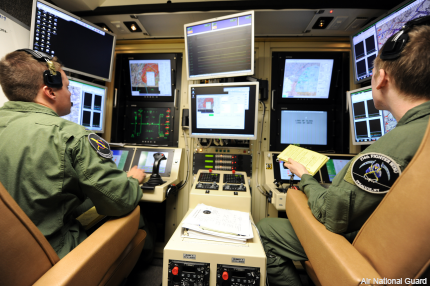National Guard wants to make more domestic use of drones
A recent report outlines the uses unmanned aerial vehicles could serve in domestic airspace, as well as the constraints standing in the way.

A student pilot and sensor operator man train on an MQ-9 Reaper Hancock Field Air National Guard Base.
NPR reports that the Guard has requested additional unmanned aerial vehicles to assist with various missions, mostly linked to surveillance of national borders, but they could also have other uses. A new report from RAND Corp. evaluated in depth the issue of domestic UAV operation and defined five mission types the Guard’s MQ-1 Predators and MQ-9 Reapers would be beneficial for: border countermigrant, border change-detection, maritime counterdrug, incident-reconnaissance (as in emergencies) and fixed-target surveillance.
Among several constraints standing in the way for greater use of UAVs, though, are domestic airspace regulations issued by the Federal Aviation Administration. While the FAA has been glacially studying the issue of integrating UAVs of all shapes and sizes into the national airspace – the most heavily trafficked and safest in the world – general use is banned, even for government use, with a few exceptions.
The FAA requires the government to obtain certificates of authorization, which for now are limited to operations along the Mexican and Canadian borders for surveillance and military bases that host these aircraft for training. Customs and Border Protection has been operating military-grade MQ-9 Reaper drones and its maritime variant Guardian for some time in patrolling U.S. borders. Such certificates require petitioners to “include descriptions of intended flight operations, RPA characteristics, and lost link procedures.” Approval can take up to 60 days, with expedited applications for emergencies.
The Guard has 48 UAVs—14 MQ-9 Reapers and 34 MQ-1 Predators, RAND said (and plans over the next five years to replace most the Predators with the more advanced Reapers, which add synthetic aperture radar to the types of optical sensors the Predator has). Because of the high demand for these platforms, about 40 percent of the Guard’s fleet have been deployed overseas, piloted remotely from Guard bases in the states, the report said. Special Operations Command also has commandeered Guard aircraft for its own purposes.
In addition to FAA rules, there are some other hurdles the Guard would have to clear before making more use of its drones. For one, the secretary of defense must explicitly approve of any use of DOD UAVs domestically. For another, there are the high costs associated with operating these complex systems. The RAND report notes that costs for MQ-1 Predator missions run about $618 per flying hour for DOD and about $777 per hour for other users. MQ-9 Reaper missions cost DOD $1,142 per hour, and other users $1,322.
One area where National Guard leaders think drones would be useful is in assisting with disaster response, or in some cases preventing them. "Most of the time, I work for the governor,” Col. Keith Albritten of the Tennessee Air Guard told NRP. “How can I help the governor? How can I help him in his state with the problems that he has."
Firefighters used to drone to help battle wildfires researchers have suggested including drones as part of a system to detect wildfires early, before they get out of hand. The advanced sensing platforms outfitted on National Guard UAVs also could be used to image infrastructure prior to incidents and compare images captured in fly-overs following disasters. This is a more efficient method of damage assessment. Further, these sensors can assess safe routes for evacuation immediately following an incident such as a flood and identify threatening regions to steer clear of.



